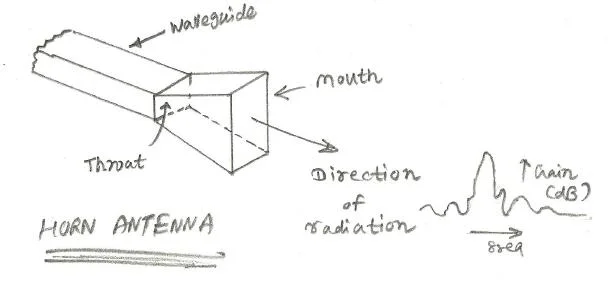Antenna Tutorial
This antenna tutorial covers antenna functions, antenna terms, antenna types, antenna gains, Antenna Gains vs Effective Area, radiation pattern, near field and far field region and testing methods. It also covers antenna terms Gain, Squint, Bore sight, Polarization, Elliptical Polarization, Circular Polarization, Linear Polarization, Beam width, G/T, Cross polarization, Sensitivity , Efficiency,Directivity etc.
Antenna is a device used to transmit and receive electromagnetic waves. The electro-magnetic waves carry information such as voice, data, video, image etc. REFER our page on what is wireless to know more on electromagnetic wave➤.
Antenna Functions
As Antenna resides between cable/waveguide and the medium air, the main function of antenna is to match impedance of the medium with the cable/waveguide impedance. Hence antenna is impedance transforming device. The second and most important function of antenna is to radiate the energy in the desired direction and suppress in the unwanted direction. This basically is the radiation pattern of the antenna. This radiation pattern is different for different types of antennas.
Field regions around antenna

Near field Region: The distance up to 2*Square (D)/Lambda is called near field region. Here D is the antenna diameter and Lambda is wavelength of free space. This region is further divided into two parts. The region up to 3*Lambda is called reactive or evanescent region, here wave is of non-propagating type. The region above 3*Lambda is called radiating region or Fresnel region.
Far field Region: The distance beyond limit of near field region is called far field region. This region is also called as Fraunhofer region. In these region power radiated from antenna decays inverse of square of distance.
Types of Antenna

There are two main types: non-directional antenna and directional antenna.
Non-directional antenna radiates energy in all the direction, which is also called as isotropic antenna. In fact there is nothing like ideal isotropic antenna, each antenna will have some directivity. Simple half wave dipole falls in this category. It is also called as Hertz antenna. This antenna has omni-directional radiation pattern in one direction. It has figure eight shape radiation pattern in the other two dimensions.
Directional antenna transmits/receives energy to/from particular direction. Parabolic antenna, horn antenna falls
in this category. This parabolic reflective antenna is widely used in microwave and satellite applications. They focus energy in particular direction.
Types of Antenna➤.
Antenna Gains vs Effective Area
This page describes antenna gain equation,Antenna Gains vs Effective Area for various types of antennas, Antenna Gains➤.
Some useful terms related to antenna
Gain: Antenna gain is the ratio of power radiated in the direction of interest with respect to the power radiated in the same direction by an isotropic antenna. In other terms gain is the product of antenna efficiency and antenna directivity.
Squint: Main beam of radiation pattern is shifted from its normal position that shift is called squint (degree of shift).
Bore sight: The direction of maximum gain.
Polarization: It is defined in terms of the direction in space of electric field vector.
Elliptical Polarization: The polarization of an electric field which changes in both direction and amplitude synchronously with the radio frequency.
Circular Polarization: A special case of elliptical polarization in which the amplitude is constant and the direction rotates synchronously with the radio frequency.
Linear Polarization: The polarization of an electric field whose amplitude changes at the radio frequency rate and whose direction remains fixed.
Beam width: The angle between half power points on the major lobe corresponding to maximum gain, usually in the principal plane.
G/T: Ratio of antenna gain to receiving system noise temperature. It is called figure of merit.
Cross polarization: The component of the electric field normal to the desired polarization.
Sensitivity: The minimum level of the signal antenna can receive is called it's sensitivity.
Efficiency: Ratio of total power radiated by antenna to the input power of antenna.
Directivity: It is the ability of an antenna to focus energy in a particular direction when transmitting or to receive energy better from a particular direction when receiving.
Antenna radiation pattern measurements
An antenna has a radiation pattern that is a function of the relative angle between the test and source antennas. When an antenna radiates more energy in one direction than another, it is said to have gain in that direction. To measure radiation properties of a highly directional horn antenna, we place a source antenna a certain distance away from a test antenna and measure the signal transmission level as the test antenna is rotated.
Antenna Manufacturer
Visit vendors section of our website for antenna manufacturers/suppliers.READ MORE.
Antenna Related Links
Types of antenna TV Antenna TV Antenna Booster Satellite Dish Antenna Mobile Antenna Antenna Installation
Antenna Calculators
Antenna Gain calculator
Antenna G/T Ratio calculator
Parabolic Dish Antenna
Antenna Near Field
Horn Antenna
